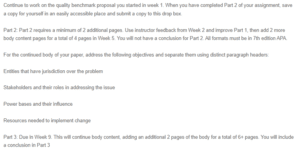We’ll write everything from scratch Question Continue to work on the quality benchmark proposal you started in week 1. When you have completed Part 2 of your assignment, save a copy for yourself in an easily accessible place and submit a copy to this drop box. Addressing the Importance of Inter-Departmental Communication in Healthcare Part 2: Part 2 requires a minimum of 2 additional pages. Use instructor feedback from Week 2 and improve Part 1, then add 2 more body content pages for a total of 4 pages in Week 5. You will not have a conclusion for Part 2. All formats must be in 7th edition APA. For the continued body of your paper, address the following objectives and separate them using distinct paragraph headers: Entities that have jurisdiction over the problem Stakeholders and their roles in addressing the issue Power bases and their influence Resources needed to implement change Part 3: Due in Week 9. This will continue body content, adding an additional 2 pages of the
Addressing the Importance of Inter-Departmental Communication in Healthcare
This quality benchmark study will examine the critical issue of inter-departmental communication in healthcare and its effects on patient safety and overall quality of care. This essay will examine the value of clear communication between medical staff members and any prospective changes that can improve patient outcomes. After reading this essay, one will better understand the value of interdepartmental communication, the state of the field’s research, and potential ways to improve it.
Do you need help with your assignment? Contact us.
Description of the Quality Issue
The value of departmental communication in healthcare is the quality issue this benchmark project addresses. It is essential for ensuring patient safety and raising the overall quality of treatment so that healthcare workers from various departments communicate effectively with one another. Ineffective communication can result in medical errors, treatment delays, and subpar patient outcomes (Kiani, 2022). This critical problem interferes with the cooperation and coordination required to deliver timely and effective healthcare services. Recognizing the issues and looking into potential fixes can help improve departmental coordination, eventually improving patient safety and the standard of care provided.
Background Information of the Quality Issue
The delivery of healthcare must include effective communication since it is essential to guarantee patient safety and raise the standard of care as a whole. Several departments and specialties collaborate in healthcare facilities to give patients complete and coordinated care. Interdepartmental communication problems, however, can have substantial negative effects on patients. Ineffective communication between medical staff members can result in compromised patient outcomes, diagnostic and therapeutic delays, and medical errors. Medication errors, wrong test orders, duplicate tests, and pointless processes can all result from poor or nonexistent departmental communication (Mertens et al., 2022). It can also result in losing important information that could affect patient care, inadequate handovers during shift changes, and delays in patient transfers.
Communication problems may be exacerbated by the hierarchical structures within healthcare companies, the complexity of healthcare systems, and the hurried nature of healthcare surroundings. Differences in communication styles, a lack of defined communication procedures, insufficient information exchange, and haziness in roles and duties can all contribute to ineffective communication. According to research, effective interdepartmental communication has been linked to better patient outcomes, lower hospital readmission rates, decreased medical errors, and enhanced patient safety (Buja et al., 2022). It encourages teamwork, collaborative decision-making, and a comprehensive strategy for patient care. As a result, improving inter-departmental communication is essential for raising the standard of care given to patients.
Previous Attempts to Address the Quality Issue
Prior attempts have been made to address the inter-departmental communication quality issue in the healthcare industry. Several methods have been put into place to improve communication and foster collaboration among healthcare workers from various departments. To ensure efficient information sharing during patient transfers or shift changes, standardized communication protocols, such as structured handoff processes and checklists, have been established and put into place. The introduction of interdisciplinary team meetings has also allowed healthcare experts from diverse departments to come together, exchange information, talk about patient issues, and reach conclusions as a group.
Additionally, technological solutions have greatly aided the development of inter-departmental communication. The use of traditional paper-based records has decreased due to the seamless access and sharing of patient information made possible by electronic health records (EHRs). Additionally, secure messaging platforms have been implemented, allowing healthcare workers to communicate instantly and share information quickly. Despite these efforts, problems still exist. Time restraints, hierarchical systems, and opposition to change are some of the factors that continue to obstruct efficient communication techniques.
Entities That Have Jurisdiction Over the Problem
Healthcare Regulatory Bodies
Regulating organizations, both public and private, is essential to monitoring and controlling medical procedures. Regulating organ
